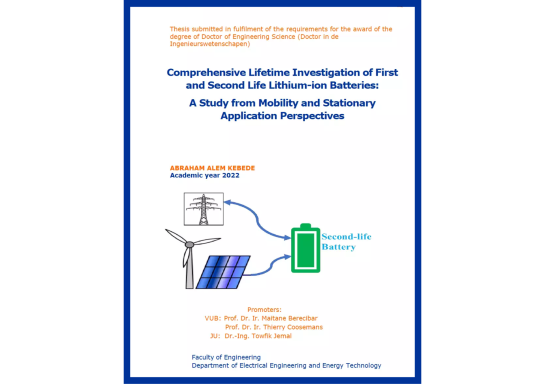
Nowadays, it is expected that the future electricity generation mechanisms could mitigate the challenges related to fossil fuel utilization for the purpose of electrification with the replacement by clean and renewable energy sources (RE Ss). However, the critical problem with the RES s (solar and wind) is that the output power is intermittent in nature and this fluctuation affects the grid stability and reliability. Therefore, energy storage technologies, specifically battery energy storage systems (BESS), have been recognized as one of the most promising approaches in a stationary application.
Nevertheless, a serious weakness of the BESS is their high costs, which represents a prominent barrier to their use in automotive applications or as grid connected energy storage. To this end, an effective solution is to repurpose or reuse the battery systems after retired from vehicular services. Accordingly, second life batteries (SLBs) are still expected to store and deliver substantial energy in low demanding stationary applications. However, the uncertainty on the degradation mechanisms in these SLBs is another challenge that needs deep investigations to ensure prolonged lifetime services.
Therefore, in this PhD thesis, a comprehensive lifetime investigation of the first and second life batteries have been performed by considering both electric vehicles (EVs) and stationary application scenarios respectively. To investigate the first life aging mechanism of the battery cells, an extensive cycling and calendar lifetime characterization is performed. Accordingly, a combined lifetime model is parametrized and developed for predicting the state of health (SOH) in terms of capacity fade and internal resistance growth of the cells. The lifetime model is coupled with a dual polarization equivalent circuit model (DP) based electro thermal model, which has initially been used to identify the electrical and thermal behavior of the battery. The validation of the lifetime model is then conducted by using a Worldwide harmonized Light vehicle Test Cycle (WLTC) profile, and a promising accuracy with root mean square error (RMSE) of 2 was achieved.
In addition to the first life aging study, the representative SLBs are selected by considering the requirements of the stationary application, and then the cell and module level aging of SLBs is performed using a stationary cycling current profile. Advanced moving average ramp rate compliance (MARRC) based battery sizing and cycling current profile definition technique has been applied. Based on the lifetime characterization and the respective model validation results, this research identified that the nickel manganese cobalt oxide (NMC) based lithium ion (Li-ion) batteries under study show promising performance in both mobility and stationary applications. The result also proved that SLBs are a technically viable solution for the RESs power smoothing application considered in this thesis.
